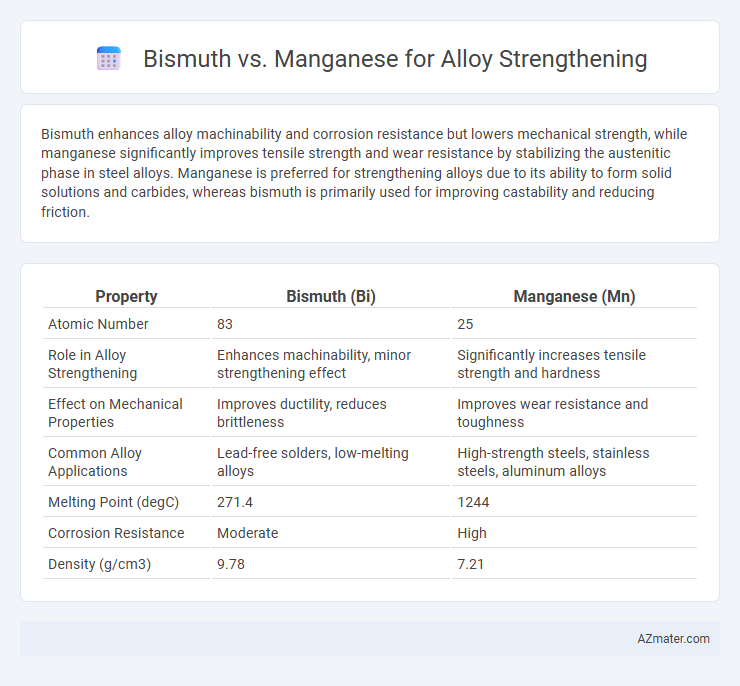Bismuth enhances alloy machinability and corrosion resistance but lowers mechanical strength, while manganese significantly improves tensile strength and wear resistance by stabilizing the austenitic phase in steel alloys. Manganese is preferred for strengthening alloys due to its ability to form solid solutions and carbides, whereas bismuth is primarily used for improving castability and reducing friction.
Table of Comparison
| Property | Bismuth (Bi) | Manganese (Mn) |
|---|---|---|
| Atomic Number | 83 | 25 |
| Role in Alloy Strengthening | Enhances machinability, minor strengthening effect | Significantly increases tensile strength and hardness |
| Effect on Mechanical Properties | Improves ductility, reduces brittleness | Improves wear resistance and toughness |
| Common Alloy Applications | Lead-free solders, low-melting alloys | High-strength steels, stainless steels, aluminum alloys |
| Melting Point (degC) | 271.4 | 1244 |
| Corrosion Resistance | Moderate | High |
| Density (g/cm3) | 9.78 | 7.21 |
Introduction to Alloy Strengthening
Bismuth enhances alloy strengthening by promoting grain refinement and improving machinability through its low melting point and brittle nature, which disrupts dislocation movement in metals. Manganese contributes to alloy strength by forming solid solution strengthening and enhancing hardenability, particularly in steel alloys, through its ability to bind with sulfur and prevent brittleness. Both elements influence the microstructure of alloys differently, with manganese primarily increasing toughness and hardness, while bismuth improves machinability without significantly compromising strength.
Overview of Bismuth and Manganese as Alloying Elements
Bismuth and manganese serve distinct roles as alloying elements, with manganese primarily enhancing strength, hardness, and wear resistance in steel through solid solution strengthening and carbides formation. Bismuth, a heavy metal with low melting point, is often used to improve machinability and reduce melting temperature but generally provides limited strengthening effects. The choice between manganese and bismuth depends on the desired mechanical properties, where manganese contributes significantly to alloy strength and toughness while bismuth influences manufacturing traits.
Chemical Properties: Bismuth vs Manganese
Bismuth exhibits low chemical reactivity with a melting point of 271.5degC and atomic number 83, contributing to its role as a solid lubricant and grain refiner in alloys without significant oxidation. Manganese, with a higher melting point of 1244degC and atomic number 25, is chemically active, enhancing alloy strength by forming stable carbides and oxides that improve hardness and corrosion resistance. The contrasting chemical properties of Bismuth and Manganese directly impact their effectiveness in alloy strengthening, with Bismuth offering brittleness reduction and Manganese providing structural reinforcement through chemical bonding.
Mechanical Strengthening Mechanisms
Bismuth and manganese both influence alloy mechanical strengthening but through distinct mechanisms. Bismuth primarily enhances strength via grain boundary segregation, reducing grain boundary sliding and improving creep resistance. Manganese increases tensile strength and hardness by solid solution strengthening and by promoting the formation of fine precipitates that hinder dislocation movement.
Effects on Microstructure and Grain Refinement
Bismuth in alloys promotes grain refinement by segregating at grain boundaries, which enhances microstructural stability and prevents grain growth. Manganese contributes to alloy strengthening through solid solution strengthening and the formation of fine intermetallic phases that refine the grain structure and increase dislocation density. Both elements improve mechanical properties, but manganese's ability to form stable precipitates offers more significant grain boundary strengthening compared to bismuth's boundary segregation effect.
Corrosion Resistance in Bismuth and Manganese Alloys
Bismuth alloys exhibit moderate corrosion resistance, particularly in acidic environments, due to their low reactivity and ability to form protective oxide layers. Manganese alloys enhance corrosion resistance by promoting the formation of stable manganese oxides, which act as a barrier against oxidation and sulfur compounds. Comparative studies show manganese-based alloys outperform bismuth alloys in severe corrosive conditions, especially in marine and industrial atmospheres.
Environmental and Health Considerations
Bismuth offers a non-toxic alternative to heavy metals like lead in alloy strengthening, minimizing environmental pollution and health risks associated with metal exposure. Manganese, while essential for steel and aluminum alloys, poses inhalation hazards during processing and can contribute to neurological issues in workers if not properly controlled. Selecting Bismuth over Manganese can reduce occupational health hazards and contribute to greener manufacturing processes due to its lower toxicity and environmental impact.
Industrial Applications: Bismuth-Alloyed vs Manganese-Alloyed Metals
Bismuth-alloyed metals enhance machinability and reduce tool wear in precision industrial components, making them ideal for applications requiring tight tolerances and complex shapes. Manganese-alloyed metals significantly improve tensile strength and impact resistance, which are crucial for heavy-duty machinery, automotive parts, and structural steel frameworks. Industrial applications benefit from selecting bismuth alloys for high-precision machining tasks, while manganese alloys are preferred where durability and load-bearing capacity are paramount.
Cost and Availability of Bismuth and Manganese
Bismuth is rarer and more expensive than manganese, which is abundant and cost-effective as an alloying element. The high availability of manganese makes it the preferred choice for large-scale alloy strengthening applications. In contrast, bismuth's limited supply and higher cost restrict its usage to niche applications where specific material properties are desired.
Conclusion: Optimal Choice for Alloy Strengthening
Manganese is the optimal choice for alloy strengthening due to its superior ability to enhance tensile strength, hardness, and corrosion resistance in steel and other metal alloys. Bismuth, although useful for improving machinability and environmental compliance, does not significantly contribute to strength or durability. Therefore, manganese remains the preferred element in applications demanding robust mechanical performance and structural integrity.

Infographic: Bismuth vs Manganese for Alloy strengthening
 azmater.com
azmater.com